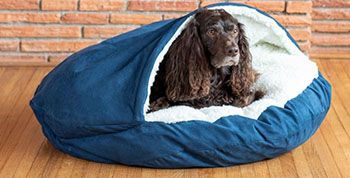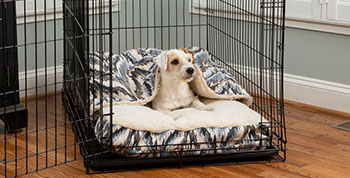Why do dogs cry in their sleep?
Anyone who’s spent time around a dog is familiar with this scene: the dog is fast asleep, paws gently paddling as they chase after a squirrel in their dream, then suddenly they start crying and whimpering. What’s going on? Why do dogs cry in their sleep? And is it okay, or is it cause for concern?
Why dogs cry during sleep:
A dog’s sleep cycle
Dogs, like humans, have sleep cycles that include phases of light and heavy sleep. While human sleep cycles generally last around 90 minutes, dog’s sleep cycles are considerably shorter. In a 45-minute nap they can go through two sleep cycles, each of which has a period of REM sleep of 1-5 minutes. Fun fact: smaller dogs have shorter REM periods, and larger dogs have longer ones.
REM, or rapid eye movement, sleep is when dreaming occurs. This is the period of sleep where your dog may “act out” their dreams by moving their legs or paws, making faces, growling, whimpering, or crying. You’ll also see their eyes flutter and move; this is the rapid eye movement that gives this phase of sleep its name.
This is all very normal and indicates a dog experiencing healthy sleep patterns. So when your dog cries in their sleep, it’s most likely not a sign of distress, just a sign of deep sleep.
When to be concerned
While a dog crying in their sleep is perfectly normal, unusual crying could be a sign of a health issue that should be addressed.
REM sleep behavior disorder is one. This is when the mechanisms that are supposed to prevent the body from fully acting out the brain’s dreams don’t function properly. A dog with REM sleep behavior disorder does more than just move their legs when they’re in REM sleep, they can actually get up and run into walls, bite people or objects, and so on. It can be dangerous for the dog and for the people around them. The good news is that because the behavior is so extreme, it’s not difficult to diagnose this disorder, and it can be treated with medication like clonazepam.
Seizure disorder is another. Seizures occur when there’s a sudden spike of electrical activity in the brain. This may be accompanied by “running” movements in the legs, twitching in the face and paws, and vocalizations including crying. Since seizures are more likely to occur in dogs (and humans) as brain function changes from one state to another, such as going from being awake to sleep or vice versa, it can be challenging to determine whether your dog is acting out normally in REM sleep or having a seizure, especially if it’s a small (“petit mal”) seizure. Keep notes on how your dog behaves and try to take a short video on your phone to show your vet if you think your dog may have regular seizures. And resist the urge to touch, shake, or wake your dog during a suspected seizure, as they could bite.
Anxiety or illness are other possible reasons your dog is crying in their sleep more than normal. Look for other symptoms that might indicate an issue, such as pacing, unusual scratching, licking or biting a patch of skin raw, excessive drooling, retching, lethargy, and anything else that’s different from their usual mood or behavior.
If you’re ever concerned about your dog’s health, listen to your intuition and talk to your vet about it.
Let sleeping dogs lie
As long as your dog is in good health and doesn’t have a health condition like one of those listed above, you have nothing to worry about. Ultimately, hearing your dog crying in their sleep is more stressful for you than for your dog. Since it’s a normal part of their sleep cycle, don’t interfere by waking them up. At worst, they could snap at you, and at best, you’re disturbing their precious sleep. As the old saying goes, let sleeping dogs lie!


















